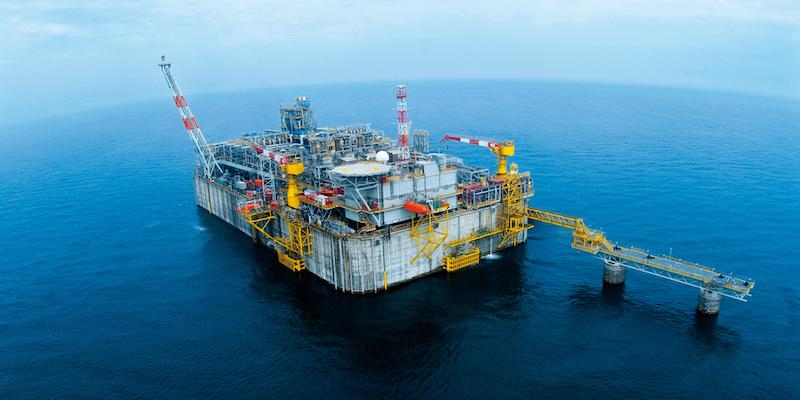One of the ways the government would like to do Reducing Italy’s dependence on Russian natural gas It is the installation of one or two new regasifiers, in addition to the three already in Italy. They are necessary to receive gas from countries to which Italy is not connected by a gas pipeline, but for many years the construction of new stations has faced strong opposition in different parts of Italy, due to their environmental impact and other reasons. That is why the government is talking about regasification devices in floating structures, which can be put into operation in a short time.
Most of the imported gas arrives in Italy via gas pipelines, that is, the long tubes through which the substance can flow. Some are entirely terrestrial, such as those that transport Russian gas and connect to the Italian network in Tarvisio, in the province of Udine, and others cross the Mediterranean. However, there is nothing to link Italy to Qatar, the third country from which more gas was imported in 2021 after Russia and Algeria, or to the Republic of Congo or Angola, countries from which the government wants to buy gas in the future. . It is clear that no one unites Italy with the United States, the number one gas producing country in the world.
In the absence of pipelines, natural gas can be transported by special methane tankers (methane is its main component). First, however, the liquid, i.e. converted into liquefied natural gas, is made in abbreviation LNG or LNG, from the English expression: in this way it occupies about 600 times less volume and the LNG carrier can transport a much larger amount. Therefore, gas transportation by ships requires gas-to-liquid stations at the point of departure (therefore, the stations cool and compress it), and regasification devices at the arrival point.
LNG is transported in ships at a pressure slightly higher than atmospheric and at a temperature of -162 ° C. In regasifiers, it returns to the gaseous state thanks to a controlled heating process inside the evaporator, which has a sufficient volume to allow the gas to expand. Heating is done by passing LNG inside tubes immersed in sea water – which is obviously of a higher temperature.
Once returned to a gaseous state thanks to regasification devices, the gas can be fed into gas pipelines in the region, to be distributed in homes and used by gas-fired power plants for energy production.
The Italian regasifiers currently in use are three different structures. The largest Adriatic LNG terminal and plant Navy: An artificial island located in the sea off Porto Viro, in the province of Rovigo, with an annual production capacity of 8 billion cubic meters of gas. It has been active since 2009 and the company it runs is one joint project It is comprised of large US oil company ExxonMobil (70 percent), state oil company Qatar Petroleum (23 percent) and Sanam (7 percent), which operates the Italian gas pipeline network.
Also in the Tyrrhenian Sea, off the coast between Livorno and Pisa, there is an offshore gas-to-gasification device: it is a LNG carrier that has been modified and permanently anchored to the sea floor and has brought gas into the grid since 2013. It has the capacity to absorb LNG. 3, 75 billion cubic meters per year; It is owned by Snam for 49.07 percent, investment firm First Sentier Investors for 48.24 percent, and to liquefied natural gas tanker leasing and management company Golar LNG for the remainder.
The third regasification factor in operation is instead a structure on the beach, which is located on the mainland, is located in Panigaglia, in the province of La Spezia. It is the first regasification device built in Italy (built in the 1970s), its annual capacity is 3.5 billion cubic meters and belongs to the hump.
The total capacity of the three regasification devices alone will not be sufficient to allow an amount of gas to enter the Italian network equivalent to that imported from Russia in recent years (29 billion cubic meters of gas in 2021). In order to reduce energy dependence in Russia, however, the government would like to exploit more regasification devices and increase imports via pipelines from countries from which Italy already supplies today: for example from Algeria, via TransMed, and from Azerbaijan, via Trans-sea Adriatic, or TAP.
The government has instructed Snam and Eni, Italy’s largest oil company, to find one or two LNG tankers to convert to Floating gas-to-gas regasification unit (In technical terminology, a regasification plant like this, or initialized FSRU), are structures similar to those off the coast of Livorno and Pisa that can process 5 or 6 billion cubic meters of gas per year. Nothing is known yet about where the implants will eventually be placed.
In this context, two projects to build new regasification devices that have been blocked for years were also discussed. One relates to Porto Empedocle, in the province of Agrigento, and the other to Gioia Tauro, in the province of Reggio Calabria.
The first project was initially presented in 2004, but after various bureaucratic fluctuations, the municipality of Agrigento stopped the construction of the gas pipeline that would be connected to the station: risks to the environment and possible damage to archaeological sites during archaeological excavations. The pipeline which they judged to be too high. In February, however, the Regional Administrative Court (TAR) in Palermo unacceptable Municipal use and now, at least in theory, the pipeline can be built. However, it is not certain that the gas-to-gas plant in Porto Empedocle will take place, and in a short time, because the municipality of Agrigento can appeal the decision of the Council of the Administrative Judiciary of Sicily (CGARS) against the TAR decision.
As for the Gioia Tauro project, which began in 2005, it has been on hold since 2013, but the Minister for Sustainable Infrastructure and Mobility, Enrico Giovannini, said it could be taken into account.
In past years it was also assumed that regasification devices would be built in other regions of Italy, but by local referendums they were set aside. In Trieste, it was feared that this would reduce the movement of goods entering the port, in Priolo, in the province of Syracuse, that the plant would be dangerous for the population.

“Coffee fan. Tv specialist. Social media aficionado. Zombie geek. Evil analyst. Web expert.”







More Stories
Spain, corruption investigations into the wife of Prime Minister Sanchez. It's a storm, are you going to quit? – the weather
Forest City, a completely abandoned $100 billion city
Never wash your car if you go on vacation to this country that Italians love so much | They will impose a fine of 3,000 euros on you